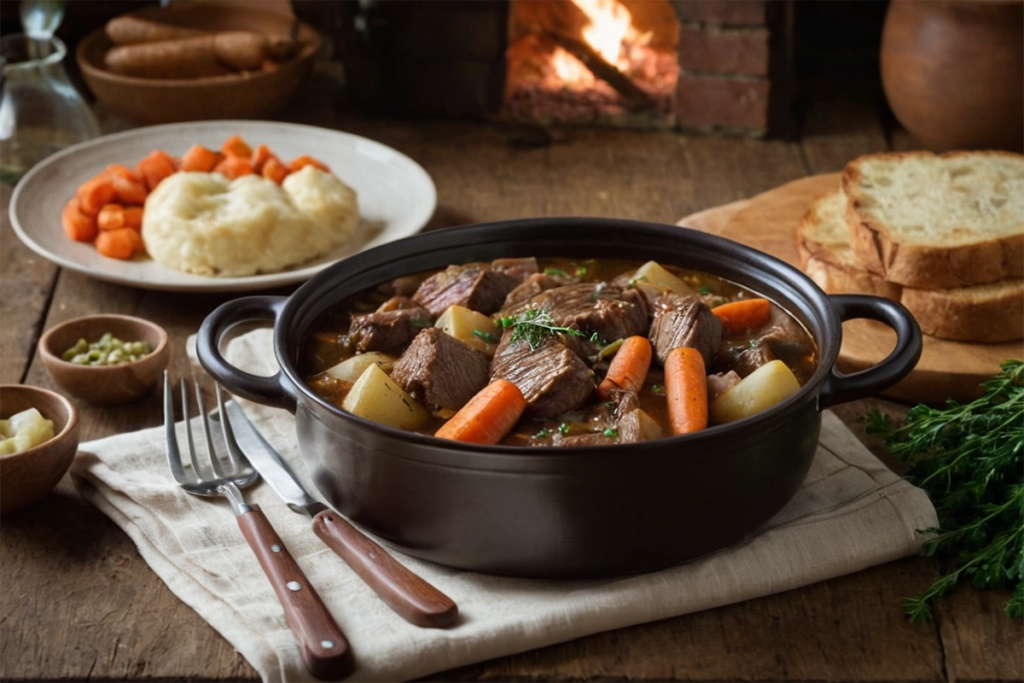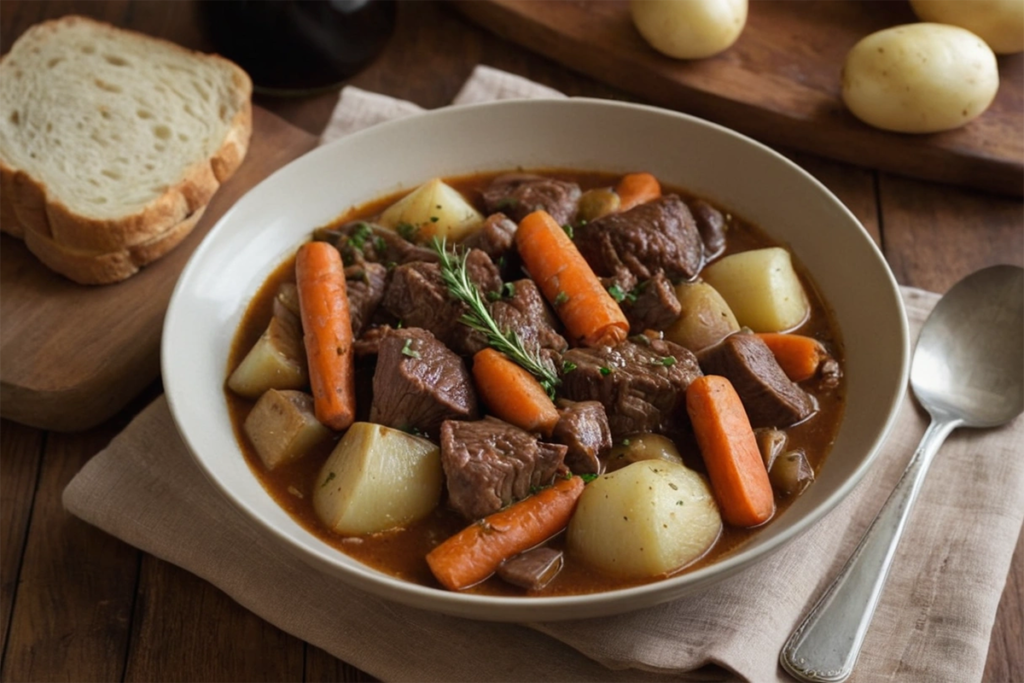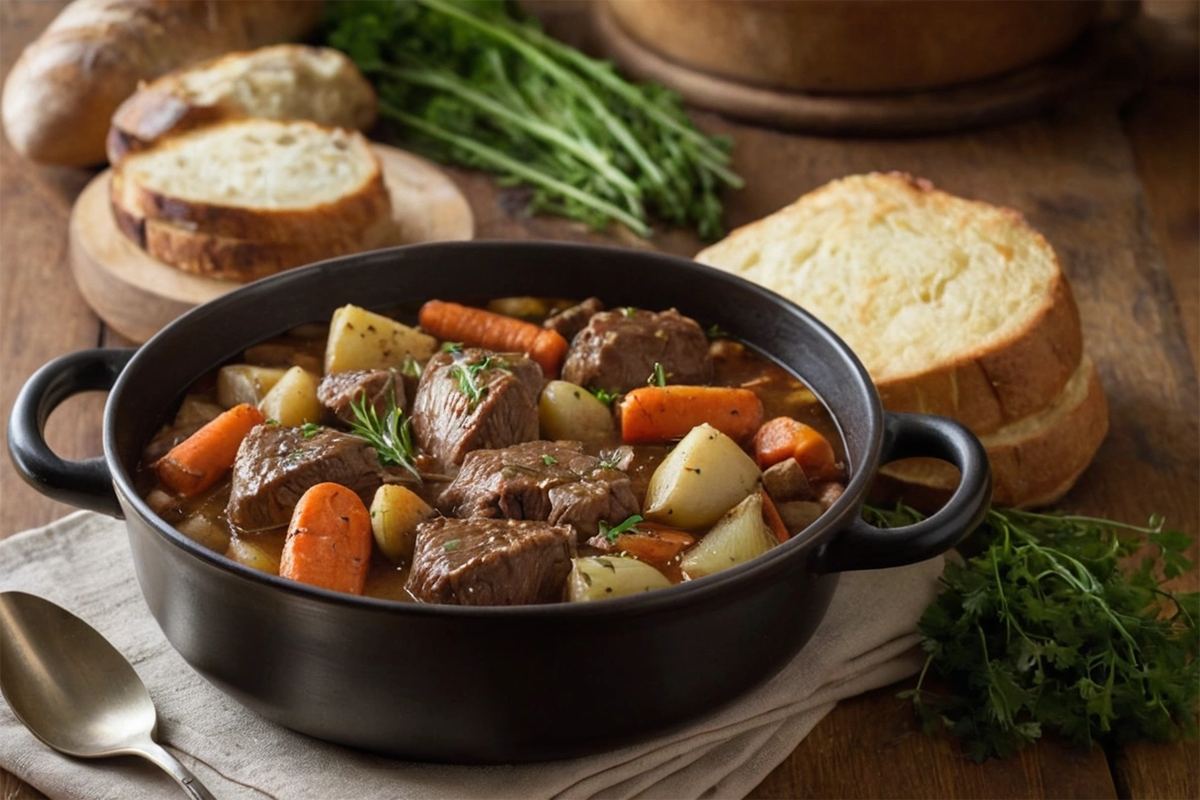Can I put raw beef in slow cooker? This is a common question among home cooks, and slow cookers have become a kitchen staple for many, offering a convenient way to prepare hearty and flavorful meals with minimal effort. The short answer is yes, but there are important considerations to ensure your dish turns out delicious and safe to eat. In this article, we’ll explore the safety, best practices, and tips for cooking raw beef in a slow cooker, along with techniques to enhance flavor and texture for dishes like Slow Cooker Beef and Noodles.
Table of Contents
Introduction to Slow Cooking
What Is Slow Cooking?
Slow cooking is a method where food is cooked at a low temperature over an extended period, typically in a slow cooker or crockpot. This cooking technique allows flavors to meld together, and meats to become tender and succulent. Slow cookers are especially popular for cooking tough cuts of meat, such as beef, because the long, slow cooking process breaks down connective tissues, resulting in a tender dish.
Slow cookers are known for their convenience, as they allow you to prepare meals ahead of time and leave them to cook while you attend to other tasks. This makes them ideal for busy households, meal prepping, and anyone looking to enjoy a home-cooked meal with minimal hands-on time.
For more on the benefits and techniques of slow cooking, you can check out this Guide to Slow Cooking Beef.
Common Questions About Raw Beef in a Slow Cooker
One of the most frequently asked questions about using a slow cooker is whether it’s safe to put raw beef directly into the appliance. The concern typically stems from worries about food safety and whether the beef will cook through evenly. In this article, we’ll address these concerns, offer tips on how to safely cook raw beef in a slow cooker, and explore the benefits of using this method.
Is It Safe to Put Raw Beef in a Slow Cooker?
Understanding the Slow Cooking Process
Slow cookers operate at low temperatures, typically between 170°F and 280°F (77°C to 138°C), depending on the setting. These temperatures are sufficient to safely cook raw beef to an internal temperature that kills harmful bacteria, such as E. coli and Salmonella. The key to safe slow cooking is ensuring that the beef reaches a safe internal temperature, which for beef is at least 145°F (63°C) for medium-rare and 160°F (71°C) for ground beef or well-done.
The low and slow cooking process not only ensures safety but also enhances the flavor of the beef. As the beef cooks over several hours, it becomes tender and absorbs the flavors of the other ingredients in the slow cooker, resulting in a rich and flavorful dish.
Safety Concerns and How to Address Them
While it is safe to put raw beef in a slow cooker, there are a few safety concerns to be aware of. One potential issue is the risk of the beef sitting in the “danger zone” (40°F to 140°F or 4°C to 60°C) for too long, where bacteria can multiply rapidly. To minimize this risk, it’s important to:
- Preheat the Slow Cooker: Always preheat your slow cooker before adding raw beef. This ensures that the beef begins cooking immediately and does not spend too much time in the danger zone.
- Cut Beef into Smaller Pieces: If you’re cooking a large piece of beef, consider cutting it into smaller chunks to ensure even cooking. Smaller pieces will cook more quickly, reducing the time they spend at unsafe temperatures.
- Avoid Overfilling the Slow Cooker: Overfilling the slow cooker can cause uneven cooking. Ensure that the beef and other ingredients have enough space to cook properly.
By following these guidelines, you can safely cook raw beef in a slow cooker without compromising food safety.
Benefits of Using Raw Beef in Slow Cooking
Using raw beef in a slow cooker offers several advantages. First, it simplifies the cooking process by reducing the number of steps required to prepare the dish. Instead of browning the beef in a separate pan before adding it to the slow cooker, you can simply place the raw beef directly into the slow cooker along with the other ingredients.
Additionally, cooking raw beef in a slow cooker allows the meat to absorb the flavors of the other ingredients as it cooks. The slow, gentle heat breaks down the beef’s connective tissues, resulting in a tender and flavorful dish. This method is particularly effective for tougher cuts of beef, such as chuck roast or brisket, which benefit from long, slow cooking.

Pre-Browning Beef: Necessary or Not?
Arguments for Pre-Browning Beef
Pre-browning beef before adding it to a slow cooker is a step that many chefs recommend for enhancing the flavor of the final dish. Browning the beef creates a caramelized crust on the surface, which adds depth and richness to the flavor. This process, known as the Maillard reaction, occurs when the proteins and sugars in the beef are exposed to high heat, resulting in a complex, savory flavor that can’t be achieved through slow cooking alone.
Another benefit of pre-browning is that it allows you to sear the beef’s exterior, locking in the juices and preventing the meat from becoming too dry during the long cooking process. While this step adds a bit of extra time and effort, the enhanced flavor is often worth it, especially for dishes where the beef is the star ingredient.
For more details on how to effectively brown beef before slow cooking, take a look at these Tips for Browning Beef Before Slow Cooking.
When You Can Skip Pre-Browning
While pre-browning beef can enhance the flavor of your dish, it is not always necessary. There are situations where you can skip this step without significantly impacting the final result. For instance, if you’re short on time or prefer a more hands-off approach, you can place the raw beef directly into the slow cooker without browning it first.
Some dishes, such as stews or soups, rely on the slow cooking process to develop their flavors, and the additional step of browning the beef may not be necessary. In these cases, the beef will still become tender and flavorful as it slowly cooks in the broth or sauce.
Practical Tips for Browning Beef
If you decide to brown the beef before adding it to the slow cooker, there are a few tips to keep in mind:
- Use a Hot Pan: Ensure that your pan is hot before adding the beef. This helps to achieve a good sear and prevents the meat from sticking to the pan.
- Avoid Overcrowding the Pan: Cook the beef in batches if necessary, to avoid overcrowding. Overcrowding can cause the beef to steam rather than brown, resulting in a less flavorful crust.
- Season the Beef: Season the beef with salt and pepper before browning. This enhances the flavor and helps to form a delicious crust on the surface of the meat.
By following these tips, you can achieve perfectly browned beef that adds depth and richness to your slow-cooked dishes.
Best Cuts of Beef for Slow Cooking
Ideal Cuts of Beef
When it comes to slow cooking, not all cuts of beef are created equal. Certain cuts of beef are better suited for slow cooking due to their higher fat content and connective tissues, which break down over time, resulting in tender, flavorful meat. Some of the best cuts of beef for slow cooking include:
- Chuck Roast: A well-marbled cut with plenty of connective tissue, chuck roast is ideal for slow cooking. It becomes incredibly tender and flavorful after several hours in the slow cooker.
- Brisket: Brisket is a tougher cut that benefits from long, slow cooking. It has a rich, beefy flavor that deepens as it cooks.
- Short Ribs: Short ribs are another excellent choice for slow cooking. The bones add extra flavor, and the meat becomes fall-off-the-bone tender after several hours in the slow cooker.
These cuts are often more affordable than premium cuts like ribeye or tenderloin, making them a budget-friendly option for slow-cooked meals.
How to Prepare Beef for Slow Cooking
Proper preparation is key to achieving the best results when slow cooking beef. Start by trimming any excess fat from the beef, as too much fat can make the dish greasy. Next, cut the beef into evenly-sized pieces to ensure even cooking.
Season the beef generously with salt, pepper, and any other desired spices before adding it to the slow cooker. This initial seasoning helps to build the flavor base of the dish. If you’re browning the beef first, be sure to pat it dry with paper towels to remove any excess moisture, which can interfere with the browning process.
Slow Cooking Beef: Step-by-Step
Step-by-Step Guide to Cooking Beef in a Slow Cooker
Slow cooking beef is a simple process, but following these steps will help you achieve the best results:
- Preheat the Slow Cooker: Turn the slow cooker on to the desired setting (low or high) and allow it to preheat while you prepare the beef.
- Prepare the Beef: Trim, season, and brown the beef (if desired) before adding it to the slow cooker.
- Layer Ingredients: Place the beef at the bottom of the slow cooker, followed by any vegetables, seasonings, and liquids (such as broth or wine).
- Set the Cooking Time: Depending on the cut of beef and the recipe, set the slow cooker to cook on low for 6-8 hours or on high for 3-4 hours.
- Check for Doneness: Use a meat thermometer to ensure the beef has reached a safe internal temperature before serving.
Common Mistakes to Avoid
While slow cooking is generally straightforward, there are a few common mistakes to avoid:
- Overfilling the Slow Cooker: This can prevent the beef from cooking evenly. Ensure there is enough space for the heat to circulate.
- Not Enough Liquid: Failing to add enough liquid can result in dry beef. Make sure there is enough broth, water, or sauce to keep the beef moist during cooking.
- Overcooking: While slow cookers are forgiving, it’s still possible to overcook beef, especially on the high setting. Check the beef periodically to avoid overcooking.
By avoiding these mistakes, you’ll be well on your way to perfect slow-cooked beef every time.
Enhancing Flavor and Texture
Adding Flavor to Slow Cooked Beef
One of the advantages of slow cooking is the ability to infuse the beef with rich, complex flavors. Here are some tips to enhance the flavor of your slow-cooked beef:
- Season Generously: Use a blend of herbs and spices, such as rosemary, thyme, and paprika, to season the beef. These spices add depth and complexity to the dish.
- Use Aromatics: Onions, garlic, and carrots are classic aromatics that enhance the flavor of slow-cooked beef. Add them at the beginning of the cooking process to allow their flavors to meld with the beef.
- Incorporate Broth or Wine: Using beef broth or red wine as the cooking liquid adds richness to the dish. The liquid will reduce during cooking, intensifying the flavor of the beef.
Incorporating Vegetables and Broth
Adding vegetables to the slow cooker enhances the beef’s flavor and creates a balanced, nutritious meal. Root vegetables like carrots, potatoes, and parsnips hold up well during long cooking and absorb the beef and broth flavors.
Moreover, the type of broth you use can significantly impact the flavor of the dish. Beef broth is a classic choice, but chicken or vegetable broth can also be used for a lighter flavor. For a more robust flavor, consider adding a splash of red wine or balsamic vinegar to the broth.
Adjusting Texture and Consistency
Managing the liquid content in your slow cooker is key to achieving the right texture for your dish. If you find that the dish is too watery, there are several ways to thicken the sauce:
- Remove the Lid: Towards the end of the cooking time, remove the lid to allow excess liquid to evaporate.
- Add a Thickener: Cornstarch, flour, or arrowroot can be mixed with a small amount of cold water and stirred into the sauce to thicken it.
- Reduce the Sauce: If the sauce is still too thin after cooking, transfer it to a saucepan and reduce it over medium heat until it reaches the desired consistency.
Finishing touches like fresh herbs or a squeeze of lemon juice can brighten the dish and add contrast to the rich, slow-cooked beef.

FAQs (Frequently Asked Questions)
Can I Put Raw Beef in a Slow Cooker?
Yes, you can safely put raw beef in a slow cooker. The low, consistent heat of the slow cooker will cook the beef thoroughly, ensuring that it reaches a safe internal temperature. Just make sure to follow food safety guidelines and avoid overfilling the slow cooker.
How Long Should I Cook Raw Beef in a Slow Cooker?
Cooking time for raw beef in a slow cooker varies by beef cut and setting. Typically, cook on low for 6-8 hours or high for 3-4 hours. Check for doneness with a meat thermometer to ensure it has reached a safe internal temperature.
Is It Better to Pre-Brown Beef Before Slow Cooking?
Pre-browning beef before slow cooking is recommended if you want to enhance the flavor of your dish. Browning creates a caramelized crust that adds depth and richness to the flavor. However, it’s not strictly necessary, and you can still achieve delicious results by cooking raw beef directly in the slow cooker.
Can I Freeze Beef After Cooking It in a Slow Cooker?
Yes, slow-cooked beef can be frozen for later use. Allow the beef to cool completely before transferring it to an airtight container or freezer bag. It can be stored in the freezer for up to 3 months. To reheat, thaw the beef in the refrigerator overnight and reheat it in the microwave or on the stovetop until warmed through.
What Are the Best Cuts of Beef for Slow Cooking?
The best cuts of beef for slow cooking have higher fat content and connective tissue. Examples include chuck roast, brisket, and short ribs. These cuts become tender and flavorful when cooked slowly, making them ideal for slow-cooked dishes.
Conclusion and Final Thoughts
Summarizing the Benefits of Slow Cooking Raw Beef
Slow cooking raw beef is a convenient and effective way to prepare tender, flavorful dishes with minimal effort. Follow the tips and guidelines in this article to safely cook raw beef in a slow cooker. Enjoy the rich, complex flavors this cooking method imparts.
Final Thoughts on Using Raw Beef in a Slow Cooker
Experimenting with slow cooking is a great way to explore new flavors and techniques in the kitchen. Whether you’re a seasoned cook or new to slow cooking, there’s always something new to learn. So don’t hesitate to try different cuts of beef, seasonings, and cooking methods to create your perfect slow-cooked dish.

